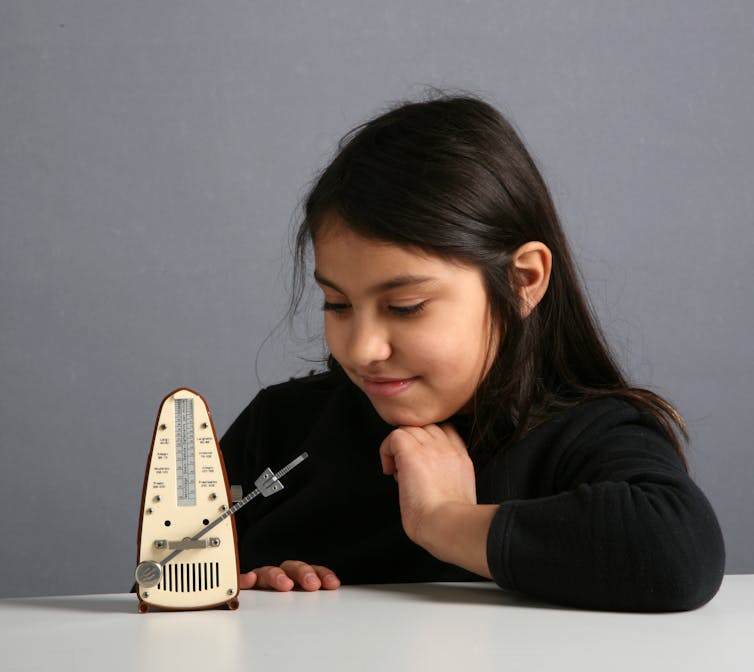Analysis: We got the beat: How we perceive rhythm involves neurological processes that control movement

Experiencing the beat of a rhythm may be influenced by the body’s expectation of movement. (Shutterstock)
BY Jonathan Joseph Cannon
October 2, 2023
When you hear a song playing somewhere, you might find yourself tapping your fingers or moving your head to the rhythm. If you’re walking, your footsteps may fall in line with the beat. Whether or not you’re a musician, somehow you know intuitively when to speed up or slow down to stay in time.
A wide range of living and non-living systems show synchronization, the tendency to coordinate rhythmic activity across interconnected groups. Pendulum clocks hanging on the same wall eventually sync up, and large groups of fireflies may start to flash as one.
But nothing else in the natural world spontaneously synchronizes with rhythms across such a wide range of tempos and with such precision as humans listening to music. Joining the flow of a rhythmic piece of music is something we think of as almost automatic. But as pleasant and natural as it may be, it’s not at all clear how we do it.
As a musician, I spend many happy hours synchronizing to rhythms. And as a scientist, I am fascinated by the processes in the mind and brain that allow us to interact so expertly and spontaneously with rhythm.
Rhythm and the brain
Our sense of rhythm would seem to begin within the confines of the mind. As we listen to rhythmic music, we intuitively know when the next note is likely to occur. We are surprised when our rhythmic expectations are thwarted, as when a prominent downbeat is played slightly early or is intentionally left silent.
But it appears that even our ability to mentally follow and anticipate musical rhythms is tied up with the brain processes we use to move our bodies.
Using functional MRI, music neuroscientists have established that actively listening to rhythm activates the supplementary motor area of the cerebral cortex and the basal ganglia in the deep brain, both of which are important for generating voluntary movements.

How is mentally following a rhythm similar to moving our bodies? In my research, I am exploring one possible link: As we move our bodies in space, we are continuously monitoring the state and progress of our actions using the sensory feedback they produce.
This process of monitoring resembles a Kalman filter, an algorithm used to track the movement of objects based on limited and noisy measurements.
I recently showed that the process of following the cycle of a periodic beat underlying a complex rhythm can also be approximated surprisingly well by a version of the Kalman filter. Anticipating and processing events in a rhythm may draw on the same brain mechanisms as anticipating and processing the sensory consequences of our own movements.
From an evolutionary perspective, I suspect that our sense of rhythm developed (at least in part) as an outgrowth of monitoring and anticipating our own footsteps as we walk or run.
Causes of motor disorders
Drawing links between motor control and rhythm perception may help us make sense of the underlying causes of neurological disorders that both affect rhythm perception and benefit from rhythm-focused therapies, including Parkinson’s, Huntington’s and stuttering.

Developmental stuttering (a stutter during speech that arises in early childhood) is associated with impairment in rhythm perception and weaker ability to tap in time with a metronome.
Conversely, stuttering can be partially alleviated by speaking along with a metronome. Further, stutterers often experience substantially improved speech when their speech is played back to them with a slight delay or a pitch shift.
Understanding the link between processing motor feedback — like the sound of one’s own speech — and perceiving an underlying beat could help us better understand stuttering by unifying the primary speech impairments with the secondary effects relating to rhythm and feedback as parts of a larger picture.
Rhythm and boundaries
The study of rhythm is one gateway to bigger questions about our relationship with the world around us. I believe that how we sense rhythm blurs the boundaries between our internal and external worlds.
We simply don’t have the cognitive resources to take all the information coming in our ears and rapidly separate it into multiple rhythmic streams. As a result, the rhythms we hear become entangled with the rhythms we make with our bodies.
As we play music in a group, we literally lose ourselves in the rhythm: we no longer predict the timing of our own sounds separately from the mix, but instead predict the timing of all sounds based on the group’s rhythm as a whole.
Prediction and action
So when we play music with others or slip into step with a friend on a walk, how does the rhythm we hear come to commandeer the timing of our actions? I suspect that the last ingredient is the tight relationship between prediction and action. According to one exciting theory of the neural control of action, we move our bodies not by sending “commands” to them, but instead by predicting what we will experience when we move them.
For example, when I fully expect to experience the sound and feeling of a handclap, my body aligns with my expectations and I clap my hands. This is one way to understand some people’s tendencies to finish others’ sentences: once they have a clear prediction of what they are going to hear, it is difficult to avoid producing those sounds themselves.
A shared rhythmic experience is a fluid interplay between sound, external expectations, self-expectation and action. As I come to understand the rhythm I’m hearing and predict its sounds, I start to predict the timing of my own actions with the same clock. And when I do that, my actions can’t help but align themselves with my predictions.
In this way, listening to and playing rhythmic music is a way to feel and act as a part of something larger than ourselves. We no longer experience ourselves as fully separate sources of sound and action — instead, we move and experience our movement as if music and movement all come from the same source, a source that includes us not as individuals but as parts of a larger system.
In a culture that often treats us as fundamentally separate and compartmentalized individuals, music helps us experience our minds, our bodies, other people, and our environments as an integrated whole.
Jonathan Joseph Cannon is an Assistant Professor of Psychology, Neuroscience and Behavior at McMaster University. This article is republished from The Conversation under a Creative Commons license. Read the original article.


